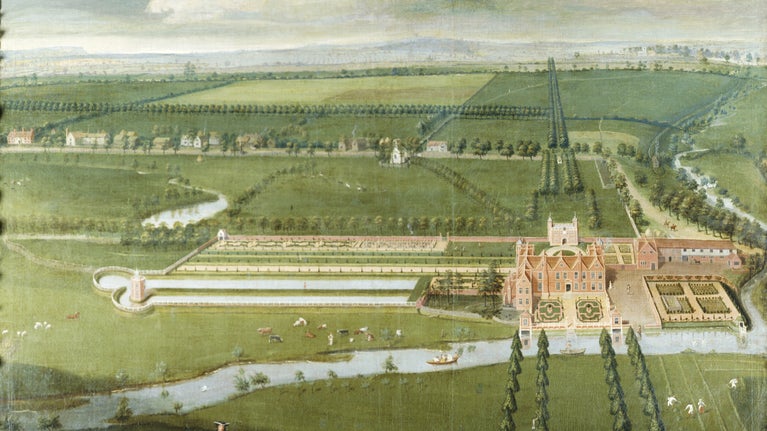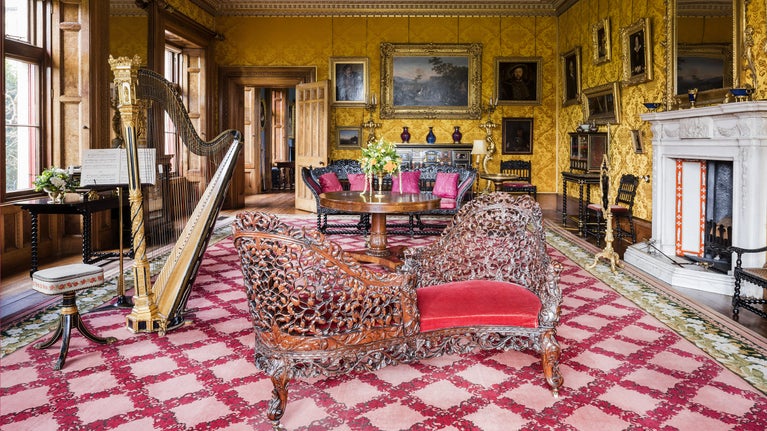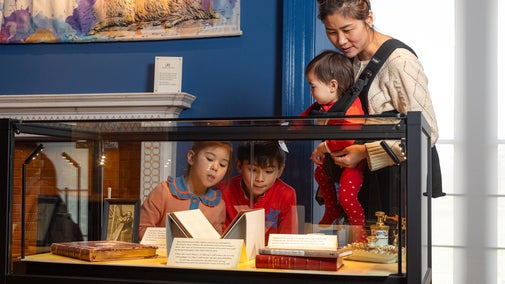
Discover more at Charlecote Park
Find out when Charlecote Park is open, how to get here, the things to see and do and more.

Home to the Lucy family for over 800 years, Charlecote Park, Warwickshire was transformed by George and Mary Elizabeth Lucy in the 1800s. It’s a place shaped by their fascination with the past. Appearing to date entirely from the 1500s, Charlecote is actually one of the country’s best examples of the Elizabethan Revival style.
Charlecote was first recorded in Domesday Book (1086) as a small trading settlement. The earliest ownership records refer to Thurstane de Montford, who styled himself Thurstane de Cherlcote.
Thurstane’s descendant, William de Cherlecote married Cecily de Lucy in 1189, founding the Lucy family line. The de Lucy (or de Luce) family migrated from France following the Norman conquest of 1066. Luce is the French word for pike, the fish that features on the family’s coat of arms.
The deer park was formally created in 1477. Fallow deer are still found at Charlecote, now roaming the park amongst ancient trees.
The family’s wealth came from land ownership and advantageous marriages. Thomas Lucy (born before 1532–1600) married heiress Joyce Acton (d. 1595) and inherited Charlecote in 1551. They demolished the medieval house and built a large brick house.
Completed in 1558, this house is partly incorporated into the present building. The impressive double-height entrance porch was decorated with Elizabeth I’s arms after a royal visit in 1572. Thomas received a knighthood in 1565, around the time the grand Gatehouse was built.
Sir Thomas Lucy III (1585–1640) inherited Charlecote in 1605. He married Alice Spencer (d. 1648) in 1610. The large portrait in the Great Hall shows Sir Thomas and Lady Lucy with seven of their children.

In 1642, Spencer Lucy (c.1614–49), a colonel in Charles I’s army, fought at the nearby Battle of Edgehill. Despite this, the parliamentary army camped overnight in the park before proceeding to Edgehill. That area, across the river from the house, is still known as Camp Ground.
Charlecote then passed to two of Spencer’s brothers. A surviving letter from Oliver Cromwell commands the presence of Richard (c. 1619–77), an MP, at Parliament.
Richard’s son, Captain Thomas Lucy (c. 1655–84), inherited in 1677. His military career is commemorated with a large portrait in the Great Hall in which he is accompanied by an unidentified enslaved boy. Although local records show that there were several Black children living near to Charlecote, the boy has yet to be identified.

Captain Thomas instigated work on a Dutch-style garden with formal flower beds, gravelled paths and two canals. After his death, the estate passed to his cousin, Colonel George Lucy (d.1721) who completed the garden.
Colonel George’s improvements were funded by his second marriage to Jane Bohun (dates unknown). Alongside other business interests, Jane’s father had considerable investments in the Royal African and East India Companies. He held senior roles in the Royal African Company in the late 1600s, when the Company engaged in the trade of enslaved people from West Africa.
The Colonel’s nephew, George Lucy (1714–86), inherited in 1744 and travelled widely. He spent time in Rome and Bath where he sat for portraitists Pompeo Batoni and Thomas Gainsborough, respectively. In Portugal, George encountered a flock of Jacob sheep and later had several shipped to England. The descendants of this flock, one of the earliest to be introduced to Britain, can still be seen in the park.
Despite periods of absence, George continued to make improvements to Charlecote. In 1757, he commissioned Lancelot ‘Capability’ Brown (1716–83) to create a new cascade. From 1760, Brown oversaw comprehensive changes. He swept away the formal garden in favour of a naturalistic landscape.
With mostly 18th-century brewing equipment and fittings, the Brewhouse is an especially rare survival. Before safe mains water, beer made here was used for home consumption by the family and workers. Special brews were made for family celebrations. The brewhouse sits amongst a range of well-preserved working buildings.
George helped David Garrick, the celebrated Shakespearean actor, to organise Stratford-upon-Avon’s first Shakespeare Jubilee in 1769. It was at this festival that a tale connecting Shakespeare to Charlecote was revived, having first been written about in 1709 by Nicholas Rowe, a biographer of the playwright.
The tale goes that Shakespeare, caught poaching, was brought before Sir Thomas Lucy I in the Great Hall and punished with a fine and possible flogging. Shakespeare may have sought revenge by ridiculing Sir Thomas as Justice Shallow in ‘Henry IV, Part II’ and ‘The Merry Wives of Windsor’.

George left the estate to a cousin, the Reverend John Hammond (1734–1823), who changed his name to Hammond Lucy. His son George (1789–1845) inherited in 1823 and soon after married Mary Elizabeth Williams (1803–90) of Bodelwyddan Castle, North Wales.
Mary was appalled by the state of the house. She complained about the ‘old worn stone floor, its small panes of glass, and old window frames creaking and rattling with every gust of wind, and so cold!’. The couple transformed Charlecote, meticulously blending the Elizabethan architecture of their ancestors with their own, recreated additions.
Working with leading designers and architects, George and Mary recalled Charlecote’s heyday. They drew upon the Elizabethan Revival style, characterised by ornate details such as decorative parapets, three-dimensional plasterwork and multi-sided towers.
Between 1829 and 1837 they oversaw the creation of a new Great Hall, decorated with family portraits and heraldic devices, and extensions to house a new service wing, Dining Room and Library. The refurbished interiors provided the perfect setting for George’s growing collection which included Tudor paintings, Indian furniture and historic books.
George made extensive purchases at the sale of the famous Fonthill Abbey collection of William Thomas Beckford (1760–1844) in 1823. Beckford’s substantial fortune was amassed through the labour of enslaved Africans on his Jamaican sugar and rum plantations. George bought over 60 items, including furniture, lacquered boxes and rare Asian ceramics.
Mary remained at Charlecote for the rest of her life. Following George’s death, she had the house and stables remodelled, and commissioned a new church, orangery and garden features. The little thatched cottage created in the mid-1800s for her children is still known as Granny’s Summerhouse. She was a prolific writer, documenting family life in her memoirs.
Mary’s son Spencer was succeeded by his eldest daughter Ada (1866–1943) who married Sir Henry Ramsay-Fairfax (1870–1944), a Scottish baronet. They had five children, whose experience growing up on the estate was later shared in ‘The Children of Charlecote’, a semi-fictionalised account by children’s author Phillippa Pearce and Sir Brian Fairfax-Lucy (1898–1973).
From the early 1900s, family fortunes diminished and Ada sold large parts of the estate. Fortunately, she retained much of the family collection, including the carriages, which are still housed at Charlecote. Henry and Ada approached the National Trust, and their son Sir Montgomerie (1896–1965) finalised the transfer in 1946.
Charlecote’s romantic appearance and sense of history have inspired generations. From the 1970s, the painter Edmund Fairfax-Lucy (1945–2020) lived at Charlecote, establishing a studio in the family wing. In 2000, he re-designed Green Court with an arrangement of box and yew hedges that complemented its Elizabethan proportions.
After centuries, Charlecote is still a family home. The family live in a wing of the house and lend many important items for display. Welcoming hundreds of thousands of visitors each year, the National Trust cares for the collection, buildings, garden and parkland.
Recent additions to the collection have included paintings of the property by Edmund Fairfax-Lucy. In 2025, the first floor of the house re-opened with a series of rooms now featuring changing displays.
Alice Fairfax-Lucy, Mistress of Charlecote: The Memoirs of Mary Elizabeth Lucy 1803-1889, Orion (2002).
Annabelle Gilmore and Jon Stobart. “Suite of Ebony Furniture Inlaid with Ivory, Charlecote Park.” In Global Goods and the Country House: Comparative Perspectives, 1650-1800, edited by Jon Stobart, 133–36. UCL Press, 2023. http://www.jstor.org/stable/jj.3508397.14.
D. Hayton, E. Cruickshanks and S. Handley eds., The History of Parliament: the House of Commons 1690-1715, https://www.historyofparliamentonline.org/volume/1690-1715/member/bohun-george-1642-1705 accessed 25 August 2021.
UCL, ‘William Thomas Beckford’, Legacies of British Slave-Ownership database, https://www.ucl.ac.uk/lbs/person/view/22232 accessed 30/05/2024.

Find out when Charlecote Park is open, how to get here, the things to see and do and more.
Discover a fine example of a Victorian home at Charlecote Park, with its vast collection of treasures and immaculately preserved Victorian kitchen and outbuildings.

Learn about the vital work we’re undertaking indoors and out at Charlecote, from restoring buildings and monitoring collection items, to maintaining healthy habitats for wildlife.

Learn about people from the past, discover remarkable works of art and brush up on your knowledge of architecture and gardens.

Explore the objects and works of art we care for at Charlecote Park on the National Trust Collections website.
